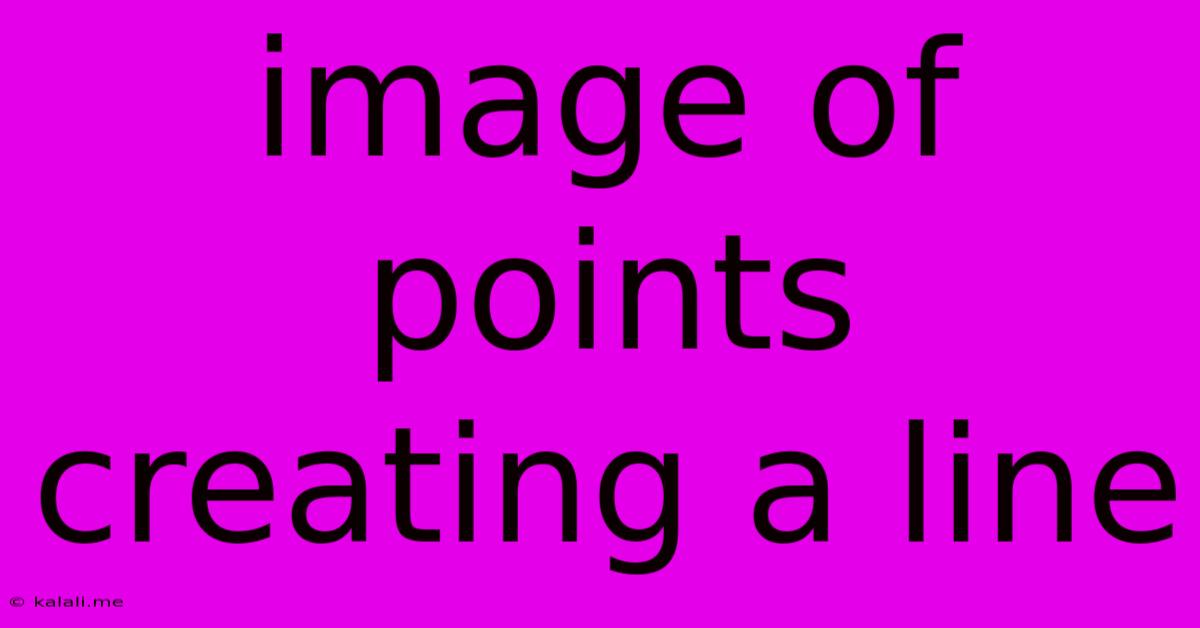Image Of Points Creating A Line
Kalali
Jun 09, 2025 · 3 min read

Table of Contents
The Power of Points: Creating Lines and Understanding Their Significance
Meta Description: Explore the mathematical concept of points forming a line, its significance in various fields, and its applications in geometry, computer graphics, and beyond. Learn about collinearity and its practical uses.
The seemingly simple concept of points creating a line underpins much of geometry, computer graphics, and even our understanding of the physical world. This article delves into the fundamentals of this concept, exploring its mathematical definition, practical applications, and broader implications. We'll uncover the power hidden within these seemingly insignificant dots and the lines they define.
Defining a Line: From Points to Infinity
In geometry, a line is a fundamental, one-dimensional object defined by two distinct points. These points, represented mathematically as coordinates, establish the line's direction and position within a coordinate system. A line extends infinitely in both directions, meaning it has no beginning or end. This infinite extension is a crucial aspect of its definition, distinguishing it from a line segment (a portion of a line between two points).
Think of it like this: you need at least two points to define a straight line. One point simply represents a location; two points establish a unique direction and, consequently, a line. Any additional points along this defined line are considered collinear.
Collinearity: When Points Align
Collinearity is the property of points lying on the same straight line. Determining whether points are collinear is a common problem in various fields, from computational geometry to spatial analysis. There are several ways to determine collinearity, including:
- Using the slope: If the slope between any pair of points is consistent, the points are collinear. This method is simple for two or three points, but becomes less efficient for a larger number of points.
- Using the determinant: For a more robust approach, especially with more than two points, the determinant method can be used. This involves creating a matrix from the coordinates of the points and calculating its determinant. A determinant of zero indicates collinearity.
- Using vector methods: Vector calculations offer an elegant way to check collinearity, particularly in higher dimensions. This involves examining the cross product of vectors formed by the points. A zero cross product signifies collinearity.
Applications of Points and Lines
The concept of points creating lines is far from abstract; it finds practical applications in numerous fields:
- Computer Graphics: Creating lines is fundamental to computer graphics. Rendering images, drawing shapes, and designing user interfaces all rely heavily on the ability to accurately represent and manipulate lines.
- Cartography: Mapping relies on representing locations as points and connecting them to form lines, paths, and borders. Understanding the relationship between points and lines is crucial for accurate map creation.
- Engineering: Civil engineering, mechanical engineering, and other branches utilize lines to represent structures, trajectories, and measurements. The precision of these lines directly impacts the safety and efficiency of engineering projects.
- Physics: The trajectory of projectiles, the path of light rays, and numerous other physical phenomena are often modeled using lines.
Beyond the Basics: Exploring Further Concepts
The basic concept of points defining a line opens the door to many more advanced concepts:
- Line equations: Representing lines algebraically through equations (e.g., y = mx + c) allows for precise calculations and manipulations.
- Intersection of lines: Finding the point where two lines intersect is a crucial task in many geometric problems.
- Parallel and perpendicular lines: Understanding the relationships between parallel and perpendicular lines allows for more sophisticated geometric analyses.
In conclusion, the seemingly simple idea of points creating a line forms the foundation for a wide range of mathematical and practical applications. Understanding this fundamental concept provides a solid base for tackling more complex geometric problems and developing proficiency in areas like computer graphics and spatial analysis. The seemingly simple relationship between points and lines holds immense power, extending far beyond the realm of theoretical mathematics.
Latest Posts
Latest Posts
-
How Many Crackers In A Sleeve Of Saltines
Jul 01, 2025
-
How Many Years Are In 48 Months
Jul 01, 2025
-
What Grade Is A 12 Out Of 15
Jul 01, 2025
-
The Opposite Of The Opposite Of Inexact Is
Jul 01, 2025
-
9am To 1pm Is How Many Hours
Jul 01, 2025
Related Post
Thank you for visiting our website which covers about Image Of Points Creating A Line . We hope the information provided has been useful to you. Feel free to contact us if you have any questions or need further assistance. See you next time and don't miss to bookmark.